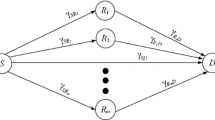Abstract
Outage probability analysis of cognitive selective DF relay networks with selection combining technique taking into account all the following issues is important: multiple SU relays, multiple PUs, non-identical independent Rayleigh fading channels, non-identical interference power limits of PUs, non-identical maximum transmission power limits of SUs, and non-identical noise powers in signals. However, no existing works solve this task exactly. In this paper, to overcome the complexity in analyzing such non-identical-parameter networks directly, we conduct the analysis in two steps indirectly. In the first step, we obtain outage probability expressions of identical-parameter networks. Then in the second step, we propose a method for transforming a non-identical-parameter network into a new identical-parameter network, meanwhile guaranteeing that the distributions of end-to-end signal to noise ratio of the two networks before and after the transformation are identical. Thus the outage probability of the identical-parameter network can be regarded as outage probability of the corresponding non-identical-parameter network. Numerical simulations validate our analysis results and confirm the feasibility of the two-step indirect analysis approach.







Similar content being viewed by others
References
Sendonaris, A., Erkip, E., & Aazhang, B. (2003). User cooperation diversity-part I: System description. IEEE Transactions on Communications, 51(11), 1927–1938.
Marinho, J. M., & Monteiro, E. (2012). Cognitive radio: Survey on communication protocols, spectrum decision issues, and future research directions. Wireless Networks, 18(2), 147–164.
Xia, M. H., & Aïssa, S. (2012). Cooperative AF relaying in spectrum-sharing systems: Outage probability analysis under co-channel interferences and relay selection. IEEE Transactions on Communications, 60(11), 3252–3262.
Marvin, K. S., & Alouini, M. S. (2000). Digital communication over fading channels: A unified approach to performance analysis. Colorado: Wiley. 2000.
Bletsas, A., Shin, H. D., & Win, M. Z. (2007). Cooperative communications with outage-optimal opportunistic relaying. IEEE Transactions on Wireless Communications, 60(9), 1–10.
Gao, Z. G., Chen, D. J., Chen, B. C., Lu, Z. M., & Yao, N. M. (2015). Outage probability equivalency of three typical relay selection schemes for selective DF relay networks with selection combining. Wireless Personal Communications, 85(3), 1205–1215.
Guo, Y., Kang, G., Zhang, N., Zhou, W., & Zhang, P. (2010). Outage performance of relay-assisted cognitive-radio system under spectrum-sharing constraints. IEL Electronics Letters, 46(2), 182–183.
Luo, L. P., Zhang, P., Zhang, G. C., & Qin, J. Y. (2011). Outage performance for cognitive relay networks with underlay spectrum sharing. IEEE Communications Letters, 16(7), 710–712.
Yan, Z., Zhang, X., & Wang, W. B. (2011). Exact outage performance of cognitive relay networks with maximum transmit power limits. IEEE Communications Letters, 5(12), 1317–1319.
Gopalakrishna, A., & Ha, D. B. (2013). Capacity analysis of cognitive radio relay networks with interference power constraints in fading channels. In Proceedings of the 2013 international conference on computing, management and telecommunications (ComManTel2013), Vietnam, pp.111–116.
Kim, K. J., Duong, T. Q., & Tran, X. N. (2012). Performance analysis of cognitive spectrum-sharing single-carrier systems with relay selection. IEEE Transactions on Signal Processing, 60(12), 6435–6448.
Si, J. B., Li, Z., Huang, H. Y., Chen, J. J., & Gao, R. (2012). Capacity analysis of cognitive relay networks with the PU’s interference. IEEE Communications Letters, 16(12), 2020–2023.
Duong, T. Q., Yeoh, P. L., Bao, V. N. Q., Elkashlan, M., & Yang, N. (2012). Cognitive relay networks with multiple primary transceivers under spectrum-sharing. IEEE Signal Processing Letters, 19(11), 741–744.
Kim, K. J., Duongy, T. Q., Tsiftsisz, T. A., & Bao, V. N. Q. (2013). Cognitive multihop networks in spectrum sharing environment with multiple licensed users. In Proceedings of the IEEE international conference on communications (ICC2013), Budapest, Hungary, June 2013.
Ding, H., Ge, J., Costa, D. B. D., & Jiang, Z. (2011). Asymptotic analysis of cooperative diversity systems with relay selection in a spectrum sharing scenario. IEEE Transactions on Vehicular Technology, 60(2), 457–472.
Gradshteyn, I. S., & Ryzhik, I. M. (2007). Table of integrals, series, and products (7th ed.). San Diego: Academic.
Acknowledgments
This work was supported by Natural Science Foundation of China (No. 61073183), Fundamental Research Funds for the Central Universities (No. 852009), and 863 Program (No. 2012AA111902).
Author information
Authors and Affiliations
Corresponding authors
Rights and permissions
About this article
Cite this article
Gao, Z., Chen, D., Yao, N. et al. Outage Probability of Cognitive Selective DF Relay Networks with Multiple Primary Nodes and Heterogenous Non-Identical Constraints. Wireless Pers Commun 92, 969–992 (2017). https://doi.org/10.1007/s11277-016-3587-z
Published:
Issue Date:
DOI: https://doi.org/10.1007/s11277-016-3587-z




